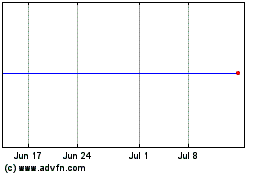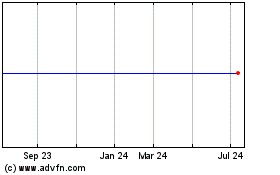AstraZeneca's Investment Eats Into Profit -- Update
April 29 2016 - 4:42AM
Dow Jones News
By Denise Roland
LONDON--AstraZeneca PLC said core profit fell in the first
quarter even as revenue rose, as it plowed heavy investment into
the development of a string of new drugs it is betting on for
growth.
The U.K.-based drugmaker said core operating profit decreased
12% to $1.6 billion, from $1.8 billion a year earlier. Revenue
increased 1% to $6.13 billion, from $6.06 billion a year earlier.
The strength of the dollar cut into the company's reported figures:
Stripping that out, operating profit fell 8%, while revenue climbed
5%.
That was in part due to higher research spending, which climbed
15% to $1.4 billion, though it also reflected a drop in income from
items such as disposals and royalty payments.
Net profit increased 17% to $646 million, from $550 million a
year earlier as a result of lower amortization charges.
Astra is furiously investing in its pipeline of new drugs to
return the company to growth following a succession of patent
expirations on its old blockbusters. The last of those--Crestor for
lowering cholesterol--is expected to face competition from a
cheaper copycat from next month.
It is also reinforcing its pipeline by gobbling up smaller
biotech companies. Astra said part of the overall increase in
research spending came from its absorption of research costs for
two recent acquisitions, ZS Pharma and Acerta Pharma.
It is betting that these new drugs won't just replace lost
revenue but catapult the company up the pharmaceutical rankings.
Chief Executive Pascal Soriot told investors that AstraZeneca,
which posted sales of $25 billion in 2015, could generate $45
billion in revenue by 2023. By comparison, the world's three
largest drugmakers--Pfizer Inc., Novartis AG and Roche Holding
AG--posted sales of around $50 billion in 2015. That promise was a
key plank in his defense against an unsolicited, and ultimately
failed, takeover bid by Pfizer in 2014.
Some new drugs are already showing promise. Revenue from
AstraZeneca's so-called "growth platforms," including new medicines
for cancer, diabetes and heart and respiratory diseases, increased
6% to $3.4 billion. But falling revenue from old blockbusters such
as Nexium for heartburn and inhaler drug Symbicort weighed on
overall product sales growth, which edged up 1% to $5.6 billion at
constant currencies.
At the same time, AstraZeneca is licensing out the rights to
pipeline drugs that don't sit within its core focus areas to raise
cash for those that do. In the first quarter, it raised $550
million in proceeds from licensing deals, up from $309 million a
year earlier. That so-called externalization revenue helped boost
Astra's top line.
The company confirmed that it expected total revenue and core
earnings per share to decline by a low-to-mid single-digit
percentage in 2016.
Write to Denise Roland at Denise.Roland@wsj.com
(END) Dow Jones Newswires
April 29, 2016 04:27 ET (08:27 GMT)
Copyright (c) 2016 Dow Jones & Company, Inc.
AstraZeneca (NYSE:AZN)
Historical Stock Chart
From Mar 2024 to Apr 2024

AstraZeneca (NYSE:AZN)
Historical Stock Chart
From Apr 2023 to Apr 2024
